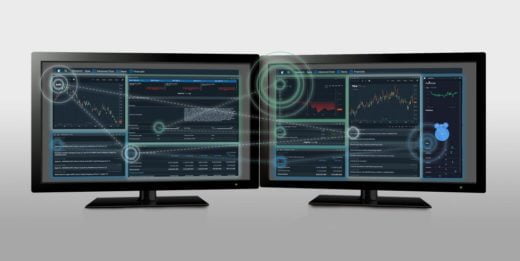The term “interoperability” is synonymous with efficient workflow across the finance industry. Today’s tech initiatives in capital markets almost always include references to automated workflows and interoperability, desktop agents and FDC3. But as ubiquitous as the term (and putting it into practice) has become, it has largely been sell-sides embarking on interoperability projects. We are beginning to see the tides turn.
In this piece, we’ll discuss why interoperability is starting to take off for buy-side firms, why the project is well worth the investment, and what we predict the future holds for buy-side interoperability.
Ask yourself: If you could automate the rote tasks your traders or portfolio managers engage with, what value would this bring your firm? That question (and the answer) is at the heart of interoperability.
What is interoperability and who is engaging with it?
The goal of interoperability is to synchronize all the applications on your desktop – no matter what type (legacy, native, in-house, or third party). Through the use of integrations facilitated by a smart desktop platform, automated workflows are built between these applications. This leads to a new streamlined user experience, eliminating the burden of application switching.
According to this Flextrade article, some buy-side traders navigate eight-ten screens throughout the day and log-in to twenty-seven different applications. However, when we took our Finsemble smart desktop platform to market in 2017, sell-sides were the most engaged. We’ve all seen the workstation of a sell-side trader: different applications spread across multiple monitors, nothing working together, constant rekeying and pasting. Errors and inefficiencies were rampant and sell-sides were seeking a solution that we set out to solve.
Additionally, the sell-side had available the IT resources to implement a desktop interoperability strategy, where asset managers and hedge funds—particularly smaller ones—did not. Sell-sides were on the lookout for a solution and had even started to solve for this problem in-house, building out monolithic platforms to try and integrate their applications manually.

Why this is the perfect time for buy-sides to generate alpha through custom workflows.
Buy-side workflows vary greatly from firm to firm, with layers of technology—at times proprietary—that do not connect. Disparate reporting systems and metrics, chat, internal risk tools, and a high dependency on virtual applications create complications.
Additionally, multitudes of systems such as OMS, PMS (and sometimes multiple EMS platforms) all launch separately and do not sync, with limited app-app communication. Errors from rekeying and copy-paste are particularly devastating due to increased regulatory scrutiny and volatility. Portfolio managers and traders are working on behalf of clients who in turn have their own systems, along with interactions with multiple sell-side firms daily. The majority of applications used by the buy-side are off-the-shelf vendor applications that (historically) don’t speak to each other.
The lack of FDC3 initiatives has been problematic for bringing interoperability to the surface. However, we are starting to see the tables turn.
Next level collaboration: Buy-side vendors and FDC3
FDC3 standards define a common language and API that applications can use to easily communicate with each other. By using this common language, FDC3-enabled applications become part of the streamlined workflows at the heart of interoperability.
Slowly but surely, application providers are getting involved in interoperability. Understanding that connectivity is imperative to buy-side workflows, they want to be key players. More and more vendors are prioritizing FDC3 to make this happen.
Meeting FDC3 compliance means these buy-side vendor applications arrive primed and ready for interoperability out-of-the-box (it’s important to note: FDC3-compliant applications can interoperate immediately once installed on a desktop equipped with an FDC3 Desktop Agent, such as Finsemble).
Some examples include Charles River, State Street, and Broadbridge. Refinitiv, FactSet and Eze are all in various stages of adoption, while Bloomberg allows interoperability using Terminal Connect. Additionally, a collaboration between Finsemble and Symphony is solving for the use case of firm-firm and person-to-person communication.
Next steps for buy-side interoperability
The possibilities for automating workflow are endless and depend entirely on what your vision is and the objectives you are trying to achieve. Ask yourself what rote tasks your portfolio managers, analysts and traders are spending their valuable time on, and trust that there is a real-world solution to simplify it.
As we meet with more and more buy-side clients, we are learning more about the unique and customized ways workflow automation will work for them, from expediting the RFQ process to automating the FX Swap process. Beware: as your front desk starts to see the power automation can bring, they’ll want to see more.
“Now we’re victims of our own success because we’ve got people banging on the door, saying can you do this, can you do that. Because they’re understanding the concept, and the power of interoperability.”
Carl James, Head of Fixed Income, Pictet Asset Management
Interoperability is moving from nice-to-have to imperative for buy-side firms. Alpha is generated at every step in the investment process. Technology has facilitated many gains, and interoperability is the next leap forward. We hope to see you participating in this new era of workflow across investment platforms. Contact us for an in-depth consultation.

Authors:
Sarah Stone, VP Product Management, Cosaic
Phil Cunn, Global Head of Sales, Cosaic
Jason Harris, Business Development EMEA, Cosaic
